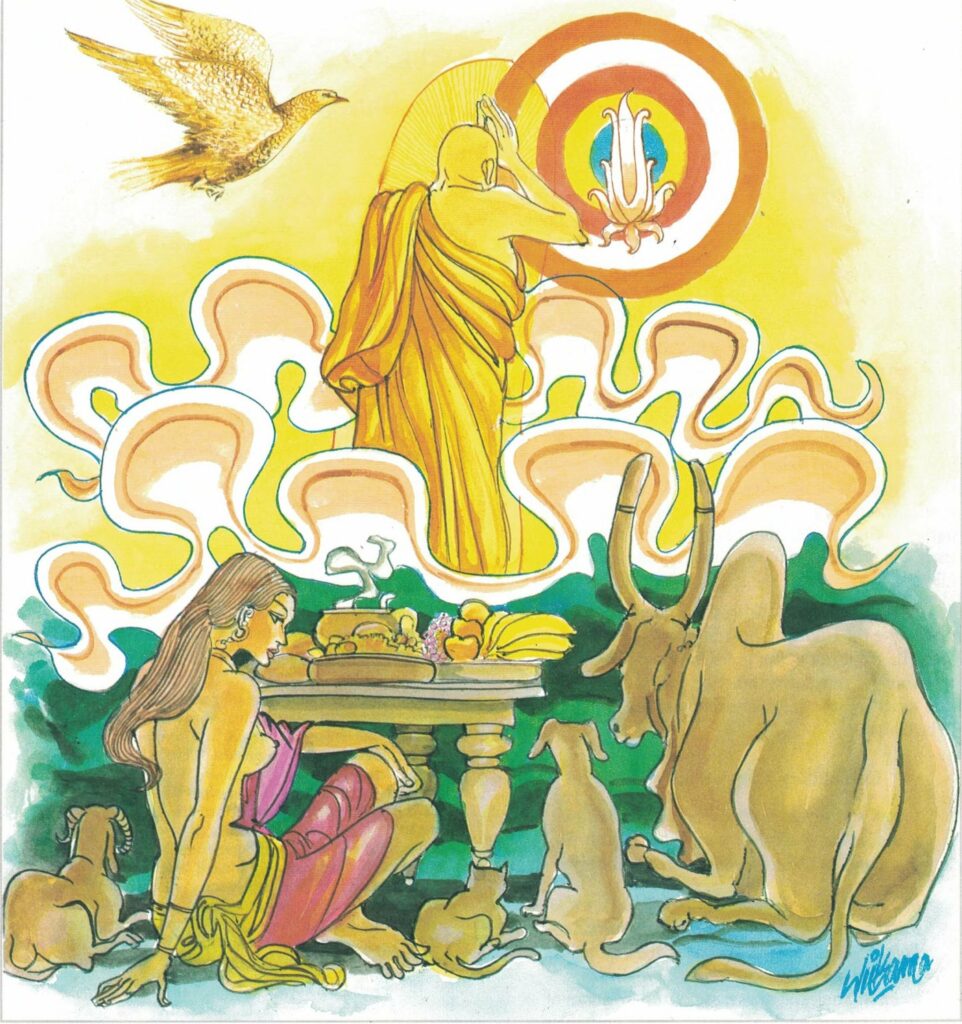Pali text, illustration and English translation of Dhammapada verse 93:
yassāsavā parikkhīṇā āhāre ca anissito |
suññato animitto ca vimokkho yassa gocaro |
ākāse’va sakuntānaṃ padaṃ tassa durannayaṃ || 93 ||
93. For whom pollutions are destroyed, he has as range the nameless and the void of perfect freedom too. As birds that wing through space, hard to trace his going.

The Story of Venerable Anuruddha
While residing at the Jetavana Monastery, the Buddha spoke this verse, with reference to Venerable Anuruddha.
One day, the Venerable, whose robes were worn out, was seeking material on refuse-heaps and in other similar places. Now in the Venerable’s third previous existence he had a wife who had been reborn in the World of the Thirty-three as the goddess Jālinī. When the goddess saw the Venerable seeking cloths for robes, she resolved to aid him. So taking three celestial cloths thirteen cubits long and four cubits wide, and thinking to herself, “If I display these cloths in this manner, the Venerable will not take them,” she went to a certain refuse-heap in front of the heap where the Venerable was seeking cloths and laid them down in such a way that only the hems were visible.
Taking the cloths with him, he went his way. On the day he was to make his robes, the Buddha, accompanied by his retinue of many monks, went to the monastery and sat down; likewise the eighty chief Venerables sat down there also. For the purpose of sewing the robes, Venerable Kassapa the Great sat at the foot, Venerable Sāriputta in the midst, and Venerable Ānanda at the head. The company of monks spun out the thread, the Buddha threaded the needle, and Venerable Moggallāna went hither and thither supplying whatever else might be needed.
The goddess entered the village and incited the inhabitants to give alms, saying, “They are making robes for my noble Venerable Anuruddha. The Buddha, surrounded by the eighty chief disciples, and accompanied by his retinue of many monks, has gone to the monastery and sat down therein. Take rice-porridge and other provisions and go to the monastery.” During the meal Venerable Moggallāna brought large pieces of rose-apple, but the monks were unable to eat it. Sakka drew a circle about the place where they were making the robes; the earth was as if dyed with lac; there was a great heap of food both soft and hard remaining over and above to the monks who had eaten.
The monks were offended, and said, “Why should such a quantity of food be provided for so few monks?” When they told The Buddha, he said, “But, monks, you do not think that this was brought by any orders of Anuruddha, do you?” “Yes, Venerable; we do.” “Monks, my son Anuruddha does not talk thus. They that have rid themselves of the corruptions do not spend their time talking about requisites; nay, these provisions were produced by the supernatural power of a goddess.”
Explanatory Translation (Verse 93)
yassa āsavā parikkhīṇā āhāre ca anissito yassa
suññato animitto ca vimokkho gocaro tassa
padaṃ ākāse sakuntānaṃ iva durannayaṃ
yassa: whose; āsavā: taints; parikkhīṇā: exhausted (gone); āhāre ca: even in food; anissito [anissita]: not attached; yassa: to whom; suññato [suññata]: emptiness; animitto ca: and objectlessness; vimokkho gocaro [gocara]: liberation are their field; tassa padaṃ [pada]: their path; ākāse: in the sky; sakuntānaṃ iva: like those of birds; durannayaṃ [durannaya]: cannot be seen
If one is totally rid of influences, internal or external, that motivate human behaviour, and is not attached even to food, that kind of individual focusses his mind on emptiness, objectlessness and freedom of thought. The path of such saints is difficult to be traced, like the path of birds flying through the sky.
Commentary and exegetical material (Verse 93)
āsavā: Usually translated as cankers, fluxes, fluxions, taints, corruptions, intoxicants, biases. We translate this word (d + sava = flowing in) as influence that motivates behaviour. Four influences are listed in the Suttas: 1) tendency towards sensual desires (kāmāsava); 2) tendency towards existence (bhavāsava); 3) tendency towards beliefs (diṭṭhāsava);and 4) tendency towards unawareness (avijjāsava). A list of three, omitting the tendency towards views is also found in the Suttas. The four-fold division also occurs under the name of ‘floods’ and ‘yokes’.
Through the path of stream-entry, the influence of views is destroyed; through the path of non-returning, the influence of sense-desire; through the path of arahatship, the influence of existence and ignorance. Buddha shows how to overcome the influences namely through insight, sense-control, avoidance, wise use of the necessities of life.
Khīnāsava, one whose influences are destroyed, or one who is influence-free, is a name for the arahat or Holy One. The state of arahatship is frequently called āsavakkhaya, ‘the destruction of the influences’. Suttas concluding with the attainment of arahatship by the listeners, often end with the words “During this utterance, the hearts of the monks were freed from the influences through clinging no more”.
This term āsava could mean impulse, urge, compulsion, motive or influence. It is similar to the term tanhā commonly translated as craving. Tanhā is also of three kinds: thirst for sensual pleasure (kāma tanhā);thirst for existence (bhava tanhā); and thirst for non-existence (vibhava tanhā).